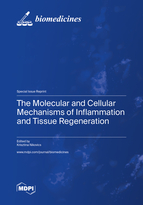The Molecular and Cellular Mechanisms of Inflammation and Tissue Regeneration
A special issue of Biomedicines (ISSN 2227-9059). This special issue belongs to the section "Cell Biology and Pathology".
Deadline for manuscript submissions: closed (30 September 2022) | Viewed by 26624
Special Issue Editor
Interests: in situ macrophage characterization; in situ hybridization; cytokine expression
Special Issues, Collections and Topics in MDPI journals
Special Issue Information
Dear Colleagues,
Understanding the processes of inflammation and tissue regeneration after injury is of major scientific and clinical importance. Immune cells are a heterogeneous population of cells that acquire their functional specialization in response to micro-environmental alterations. For a long time, immune cells have been known to trigger inflammation and coordinate an efficient repair of damaged tissue. However, the molecular and cellular mechanisms by which they exert their effects are as yet mostly unknown. When repair is not coordinated, regeneration fails and fibrosis can take place. The investigation of immune cell sub-populations by different biological, molecular and cellular methods is essential in establishing new diagnostics for multiple diseases as well as therapeutic strategies for tissue repair. This Special Issue welcomes original articles and reviews focused on the molecular and cellular mechanisms of inflammation and tissue regeneration.
Dr. Krisztina Nikovics
Guest Editor
Manuscript Submission Information
Manuscripts should be submitted online at www.mdpi.com by registering and logging in to this website. Once you are registered, click here to go to the submission form. Manuscripts can be submitted until the deadline. All submissions that pass pre-check are peer-reviewed. Accepted papers will be published continuously in the journal (as soon as accepted) and will be listed together on the special issue website. Research articles, review articles as well as short communications are invited. For planned papers, a title and short abstract (about 100 words) can be sent to the Editorial Office for announcement on this website.
Submitted manuscripts should not have been published previously, nor be under consideration for publication elsewhere (except conference proceedings papers). All manuscripts are thoroughly refereed through a single-blind peer-review process. A guide for authors and other relevant information for submission of manuscripts is available on the Instructions for Authors page. Biomedicines is an international peer-reviewed open access monthly journal published by MDPI.
Please visit the Instructions for Authors page before submitting a manuscript. The Article Processing Charge (APC) for publication in this open access journal is 2600 CHF (Swiss Francs). Submitted papers should be well formatted and use good English. Authors may use MDPI's English editing service prior to publication or during author revisions.
Keywords
- inflammation
- tissue regeneration
- immune cells
- cytokine







